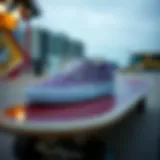Understanding Skateboard Barriers: Insights and Implications
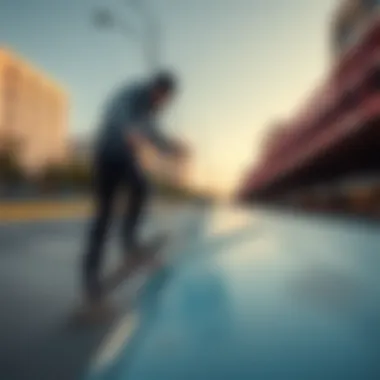
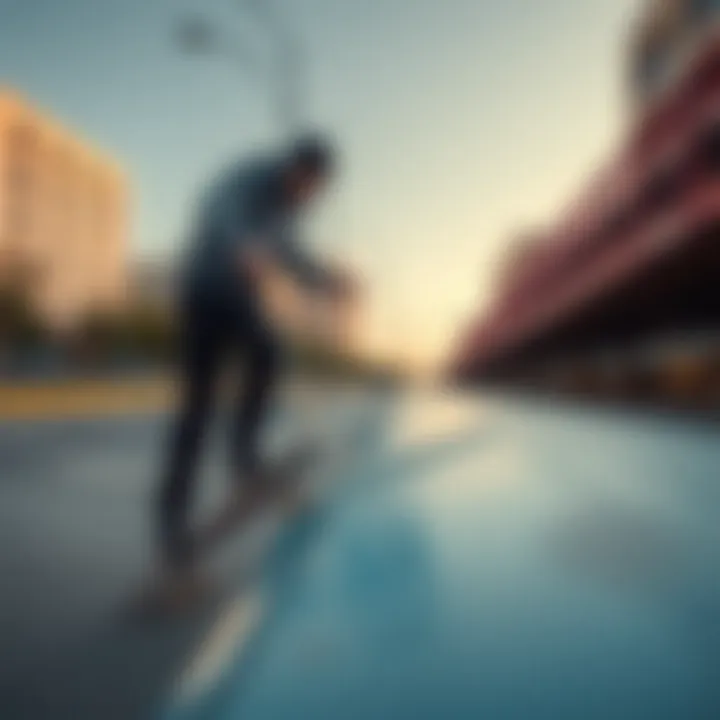
Intro
Skateboarding is not merely a pastime; it's a form of self-expression and a unique lifestyle. One element that contributes significantly to this culture are skateboard barriers, which can be both a blessing and a hurdle for enthusiasts. This article aims to shed light on the complexities of skateboard barriers and their dual role in shaping skate culture and urban environments. By examining the function of these structures, we can better understand how they influence skaters' creativity, safety, and community interaction.
Barriers can serve as platforms for innovation and skill development, while also presenting challenges that skaters must navigate. This speaks to the intricate relationship between skateboarders and urban planners, who must often work together—or sometimes against each other—to create spaces that serve multiple purposes. By gaining insight into skateboard barriers, readers can appreciate the subtle yet significant ways they impact the skateboarding experience.
Skills Development
Trick Mastery Techniques
The journey of a skateboarder often hinges on skill mastery. Barriers, such as rails, ledges, and gaps, offer unique opportunities for trick execution. Each structure demands a different set of techniques, calling for skaters to adapt and innovate. For example, a simple curb can turn into a rail with the right approach, allowing for grinds and slides that showcase an array of skills. Learning to conquer tricks in varied environment can sharpen technique and boost confidence.
- Transitions: Skaters can practice their ollies and kickflips on ledges or across barriers. These efforts help develop balance and coordination.
- Grinds and Slides: Skateboarders often utilize barriers to execute grinds, turning mundane urban features into tools for creativity.
- Manuals: A skater can practice balance by doing a manual across a low barrier, working on sustaining action over obstacles.
The thrill of nailing a trick on a barrier that initially seemed daunting can be an exhilarating experience, pushing skaters to hone their skills and expand their repertoire.
Overcoming Common Challenges
However, with great opportunities come great challenges. Skateboard barriers can present risks that require not just skill, but also careful consideration of safety. Understanding the environment is crucial for avoiding injury. Here are some common hurdles skaters face:
- Inconsistent Surface: Many barriers are made of different materials, which can affect grip and sliding potential.
- Height and Length: The dimensions of barriers can vary widely, influencing a skater's confidence in attempting tricks.
- Surrounding Environment: Urban spaces may have obstacles like pedestrians, cars, or debris that pose risks during a trick attempt.
To effectively overcome these challenges, skaters often rely on community knowledge and shared experiences. Collaborating with peers, learning from others' mistakes, and practicing in controlled environments can make tackling obstacles much more manageable.
"Every challenge is an opportunity for creativity; barriers are just a reason to think outside the box."
Community Engagement
Skate Park Spotlights
Skate parks are designed with the intent of serving as safe havens for skaters. Structures within them, including barriers, are strategically placed to encourage practice and skill development.
Some notable skate parks that feature exemplary barrier designs include:
- Venice Skate Park, California: Known for its vibrant atmosphere, this park combines a variety of barriers, catering to different skill levels.
- Cranbourne Skate Park, Australia: It offers unique shaped barriers like pyramids and ledges that challenge the norm.
- Berrics, California: This facility encourages creativity, with spaces tailored to enhance trick execution.
By examining these parks, one can understand how barriers function as training tools and community-builders.
Events and Competitions Coverage
Competitions often highlight the creativity that barriers inspire. Events like the X Games or local skate contests often incorporate barriers into their courses, providing an arena for skaters to showcase their skills. These gatherings not only spotlight talent but also foster camaraderie among skaters, all while setting the stage for thrilling performances.
The presence of barriers at these events can lead to innovative tricks being born on the spot—an aspect that many spectators cherish.
Preface to Skateboard Barriers
Skateboard barriers, while often overlooked in skate culture discussions, play a vital role in shaping the way skateboarders interact with their environment. They evoke complex emotions and can spark heated debates among urban planners, community members, and skaters alike. Understanding skateboard barriers is not merely an academic pursuit; it’s about recognizing how these seemingly mundane structures define the very spaces skateboarders traverse and engage with.
From concrete blocks to railings, barriers create both opportunities and obstacles for practitioners of the sport. Their importance stems from how they facilitate certain tricks, provide challenges for skill development, and influence the overall experience of skateboarding. Moreover, these barriers have cultural significance—becoming part of the skater's identity and artistic expression. The sight of a handrail or ledge can ignite creativity, urging a skater to push their limits and innovate.
This section serves as an introduction to the concept of skateboard barriers, setting the stage for a deeper exploration into their definition and historical context. By examining these aspects, we aim to provide insight into the dual nature of barriers—how they enhance and challenge the skateboarding experience—and ultimately encourage a more nuanced dialogue between skaters and urban designers.
Types of Skateboard Barriers
When it comes to skateboarding, barriers exist in various forms, each contributing in its own unique way to the culture and practice of the sport. Understanding these barriers is crucial for appreciating the dynamics of skateboarding, the challenges that skaters face, and how these elements influence both individual experiences and community interactions. Two significant categories emerge: physical barriers and social barriers.
Physical Barriers
Physical barriers in skateboarding encompass a myriad of structures, surfaces, and obstacles that skaters encounter in their environment. These barriers can range from ramps and rails to ledges and walls. Each type brings its own flavor to the skating experience, often dictating the types of tricks that can be performed.
For instance, a well-placed handrail might be the perfect invite for a trick like a Smith grind, whereas a large gap might inspire a daring leap. Conversely, these same obstacles can pose risks that skaters must navigate carefully. A poorly designed or unsafe barrier can lead to serious injuries, highlighting the need for thoughtful design in skate parks and urban spaces.
Here are some important considerations regarding physical barriers in skateboarding:
- Accessibility: The layout and design should allow skaters of varying skill levels to engage safely.
- Durability: Materials need to withstand the wear and tear of skateboarding activity.
- Innovation: New designs push the boundaries of what is possible in skateboarding, encouraging creativity and evolution of tricks.
As such, not only do these barriers facilitate skateboarding, but they also shape the culture, pushing skaters to innovate and think outside the box.


Social Barriers
Social barriers refer to the intangible obstacles that skaters encounter in the community and societal landscape. These can include negative perceptions around skateboarding, stigmas associated with skaters, and even regulations that limit where skating can take place.
Skateboarding has often been viewed through a lens of misinterpretation. Many associate it with delinquency or disorderly behavior, which can discourage youth from engaging in the sport. This negative association can extend to infrastructure, where cities might be less inclined to invest in skate parks despite the community's demand for them.
Here are several aspects of social barriers that warrant attention:
- Community Perception: The way communities view skaters can greatly affect participation and support for skateboarding initiatives.
- Legislation: While rules are crucial for public safety, overly restrictive regulations can alienate skaters and hinder access.
- Inclusivity: Factors such as race, gender, and socio-economic status can complicate the accessibility of skateboarding, leading to an uneven representation in the sport.
Ultimately, overcoming social barriers is as essential as tackling the physical ones. Building a positive narrative around skateboarding can lead to more robust community support and foster a more inclusive environment.
The interplay between physical and social barriers is intricate. It shapes not only individual skater experiences but also the larger skating community's identity and future trajectory.
The Role of Barriers in Skateboarding
Barriers in skateboarding play a multifaceted role, significantly shaping the practice, culture, and environment surrounding the sport. These structures, whether intended or accidental, serve not merely as physical boundaries but also as tools that skaters utilize to express their creativity and hone their skills. They influence everything from the design of skate parks to the very identity of skaters. Understanding this role helps to appreciate the nuances of skate culture as well as the challenges it faces.
Facilitating Tricks and Transitions
Barriers can become integral components of a skater's repertoire when it comes to executing tricks and transitions. Structures like ledges, rails, and ramps provide opportunities for skaters to showcase their skills, creativity, and individuality. The barriers are not just obstacles; they transform into performance enhancers. For instance, a flat rail invites countless tricks like grinds and slides, while an inclined ramp can lead to impressive air maneuvers.
Consider how the humble curb is often the unsung hero in urban skate spots. A simple barrier can inspire a whole range of tricks designed not just for spectacle but for the essence of skateboarding. In this way:
- Trick Innovation: Barriers challenge skaters to invent new tricks and styles, pushing the envelope of what’s considered possible.
- Skill Development: The presence of diverse barriers encourages skaters to practice techniques until they become second nature, enhancing their overall competency.
- Aesthetic Exploration: Many skaters also recognize barriers as blank canvases, merging art with athleticism, assembling exciting visuals as they skate.
As barriers evolve through the urban landscape, so too do the tricks that skaters can perform on them. The interplay between skater and barrier illuminates the vital role that these structures play in the very fabric of skateboarding culture.
Creating Challenges
Not everything about barriers is rosy; they often introduce challenges that can be both physical and psychological. The mere presence of a barrier can evoke complex emotions ranging from excitement to fear. This duality is an important aspect of skateboarding. For example:
- Fear Factor: When skaters face a large set of stairs or a steep ledge, it's not just about technical skill; it's a mental hurdle as well. Overcoming such barriers often leads to a boost in confidence after a successful attempt.
- Community Dynamics: Barriers sometimes draw lines within the community. New skaters may feel intimidated, while seasoned skaters might encourage them to push their limits. This dynamic fosters a culture of mentorship where barriers act as rallying points for shared experiences.
- Injury Concerns: The risks associated with attempting tricks on intimidating barriers cannot be ignored. Skaters frequently push the limits of their safety, leading to accidents that might deter newcomers from engaging with the sport.
In summary, while barriers present opportunities for innovation and creativity, they simultaneously create a landscape filled with challenges that test not only the body but also the mind. Understanding the role of barriers in skateboarding is crucial for recognizing their implications on the community and culture alike.
Impact of Skateboard Barriers on Urban Spaces
Skateboard barriers have a profound impact on urban environments, weaving into the fabric of city life while simultaneously shaping the experiences of skateboarders. These barriers, whether physical or social, frame the dynamics of skate culture and influence urban design principles. They serve as both obstacles and facilitators, illustrating the complexities of integrating skateboarding within public spaces. Understanding their impact is crucial for developing urban areas that encompass the needs of various stakeholders, especially young skaters and local communities.
Design Considerations
When pondering the design of skateboard barriers, a few critical aspects demand attention. First, there is the functionality of these barriers in the context of skateboarding. Effective design must address safety while also providing space for creativity and expression. Barriers should promote engagement without stifling the creative spirit of skaters, which often thrives on challenges. Thus, a thoughtful design might incorporate smooth surfaces for skating alongside elements that deter reckless behavior, like rounded edges and controlled heights.
Moreover, aesthetic considerations cannot be overlooked. Barriers, often seen as unwelcomed obstructions, must be integrated in a way that enhances public spaces rather than detracting from them. For instance, a barrier designed with artistic graphics or colors can transform a mundane space into a vibrant youth-friendly environment. This blend of form and function can encourage positive skateboarding culture, attracting participation and community engagement.
Additionally, accessibility plays a vital role. Skaters with disabilities should be considered in the planning stages to ensure inclusivity. This can be achieved by examining existing structures and modifying them, while also planning new verge areas that can cater to diverse abilities. By fostering inclusive environments, cities can ensure that barriers don’t just act as hindrances but as elements that promote a sense of belonging among skaters.
Community Responses
The emergence of skateboard barriers often elicits a wide range of community responses. In some cases, local residents view these structures as a nuisance, associated with noise and disturbances brought by youthful energy. On the flip side, proponents argue that these barriers provide a designated space for skaters, reducing conflicts in traditionally quieter areas. It’s a delicate balance that requires listening to all voices involved.
Communities might organize discussions, both online and offline, to address the impact of these barriers. Input from skaters, parents, urban planners, and local business owners can promote a collaborative effort in navigating design and placement. Social media platforms such as Reddit or local Facebook groups can serve as forums for exchanging views on skateboard-friendly designs and community needs.
A successful example of community engagement is evident in various skate parks around the world, where dialogues led to better outcomes. In many cities, skateboarders have become advocates in their local councils, pushing for constructions that consider their culture while maintaining neighborhood tranquility.
Efforts to create positive community relationships may include organizing events or workshops which involve skaters in educational talks about urban development and design. These workshops can help break down misconceptions and foster better relations between skaters and local authorities. Such initiatives embody a pathway towards sustainable, inclusive urban design that benefits all stakeholders.
"A well-designed urban space nurtures not only the body but also the spirit of the community. Skateboard barriers can be the catalysts for that change."
By addressing the nuanced interactions between skateboard barriers and urban spaces, planners can pave the way for environments that embrace creativity while respecting the needs of the community. Drawing from real-world experiences and stakeholder insights, a balanced approach can transform barriers into bridges between different urban cultures and skateboarding communities.
Barriers to Entry in Skateboarding
Barriers to entry in skateboarding are pivotal; they shape what the environment looks like for potential skaters while affecting the culture and community around the sport. Identifying and understanding these barriers is essential for creating a more inclusive and thriving skate community. The following sections will delve into the economic and social factors that contribute to these barriers, highlighting how they impact engagement in the skateboarding world.
Economic Barriers
When we talk about skateboarding, finances can play a massive part in who gets to skate and who doesn't. For many, the cost of equipment is a real sticking point. Quality skateboards can range from reasonably affordable to eye-wateringly expensive. While top brand names like Element, Birdhouse, and Zero are well-known for their high-end products, they might not be within reach for every aspiring skater.


The initial costs don’t stop at the board, either. Protective gear is not just important for safety; it often comes with a hefty price tag as well. Helmets, knee pads, and elbow pads accumulate in expenses. For parents or individuals on a tight budget, this can discourage participation.
Moreover, the accessibility of skate parks plays a critical role. If parks charge entrance fees or are located far from where kids live, it's a double whammy. Getting to a park often means additional travel costs or relying on others for a ride, which again affects participation.
Those who want to join the skate culture but don’t have the financial means might feel left out, fostering a sense of isolation. Such economic barriers can deter newcomers, preventing them from joining in the fun that skateboarding brings.
Quote: “Financial constraints often act as invisible walls, keeping many enthusiastic skaters from stepping into the sport.”
Social Stigmas
Social perceptions can wield tremendous influence over who participates in skateboarding. From the outset, some might associate skateboarding with rebelliousness or delinquency, which can discourage individuals from wanting to engage with the sport. These stigmas not only affect potential skaters but can permeate communities, impacting the availability and acceptance of designated skating areas.
Moreover, the skateboarder identity is often linked with certain stereotypes, such as being young, male, or from urban settings. This narrow image can make newcomers of different genders, ages, or backgrounds hesitant to pick up a board. Being made to feel out of place can be quite disheartening. If entry seems reserved for a certain type of person, it creates a barrier made not of physical materials, but of perception and belief.
Finally, instances of harassment or negative responses to skaters in public spaces can amplify these social barriers. Negative encounters can sour one’s experience and deter others from even trying to step onto a skateboard.
In summary, economic and social barriers act as significant hurdles in the world of skateboarding. Understanding these challenges is critical in paving the way to a more inclusive environment where all can enjoy the thrill of skateboarding without feeling excluded. As skate culture evolves, so too should our approach to breaking down these barriers.
Safety Concerns Associated with Skateboarding
Skateboarding, as exhilarating as it may be, carries with it a fair share of risks. This aspect is essential for anyone involved in the sport – whether you are a skater, an instructor, or someone who sells skateboards and accessories. Knowing the safety concerns can help improve our understanding of how to mitigate risks and create a safer environment for everyone around skateboarding.
Injury Risks
The landscape of injury associated with skateboarding is varied and often depends on several factors including the skill level of the skater, the type of skateboarding they engage in, and the environment where they skate. Common injuries range from minor scrapes and bruises to more severe injuries like fractures and concussions.
- Common Injuries Include:
- Fractured wrists or arms, especially when skaters fall and attempt to catch themselves.
- Ankle sprains or breaks can occur while landing tricks incorrectly.
- Head injuries are a serious concern; they can happen due to falls, which is why wearing helmets is crucial.
The underbelly of urban streets, with its enticing curbs and rails, can be a double-edged sword for skaters. While these elements provide the ultimate playground for creativity, they also introduce various hazards. One needn’t look far to hear tales of a skater who attempted to conquer a particular maneuver, only to meet the unforgiving pavement.”
"Every time you push off, there’s a balance between thrill and risk. Being prepared helps keep the enjoyment alive."
Protective Measures
To counteract the risks inherent in skateboarding, it is crucial to adopt protective measures. These can make a significant difference in reducing the likelihood of injuries. Many skaters understand the importance of their gear, but it can’t be stressed enough. Here are some vital items to consider:
- Helmets: Always wear a well-fitted helmet designed for skateboarding. It can safeguard against severe head injuries in case of falls.
- Pads: Knee and elbow pads are often underestimated but can absorb a lot of shocks in case of tumbles. They provide padding during spills, lessening the impact.
- Proper Footwear: A good pair of skate shoes with grip and support can prevent slips and provide stability while executing tricks.
- Regular Gear Checks: Equipment should be inspected regularly. Loose parts on a skateboard can lead to accidents. This audit includes checking trucks, wheels, and the condition of the board itself.
Implementing these measures creates a layer of defense for skaters while they express their creativity on wheels. The skater community thrives on pushing boundaries; however, it’s also essential to recognize the importance of safety in enjoying the sport for years to come.
Innovation Driven by Barriers
When it comes to skateboarding, barriers often lead to innovation rather than simply acting as obstacles. These impediments can inspire groundbreaking advancements in both equipment and technique, pushing skaters to think creatively when it comes to overcoming them. Barriers, in many contexts, can ignite a spark of creativity, prompting the development of solutions and styles previously unimagined.
Technical Advances in Skate Gear
The interaction between skateboarders and barriers has led to significant changes in skate gear over the years. For instance, as skaters push the envelope on what can be accomplished on their boards, equipment manufacturers have responded with improved designs that directly address the challenges posed by these obstacles. From shoes engineered for superior grip to boards made from advanced materials enabling tougher tricks, the innovations are myriad.
One notable trend is the rise of lighter, more durable skateboards. High-tech materials such as carbon fiber have found their way into skateboard production, allowing skaters to gain the momentum they need to launch off barriers without worrying about equipment failure. Moreover, the introduction of shock-absorbent cushions in trucks can save skaters from injuries during high-impact landings.
- Lighter Boards: Modern materials help skaters maneuver easily around barriers.
- Advanced Grip Systems: Shoes now feature enhanced grip to keep the skateboard secure during tricks.
- Protection Gear Innovation: Helmets and pads have evolved, focusing on both aesthetics and safety, encouraging riders to skate longer and harder.
The benefits of these advancements aren't only seen in high-level competitions; amateur skaters also reap the rewards, gaining confidence through better gear that enhances performance on various surfaces.
Creative Trick Development
Barriers have historically spurred the growth of new tricks as skateboarders learn to navigate around and on top of them. For instance, a simple bench or set of stairs can become a canvas for creativity. Instead of simply avoiding these structures, skaters often seek to incorporate them into their routines, leading to the evolution of tricks that are both complex and visually stunning.
Creativity in trick development often mirrors the unpredictability of everyday urban environments. Obstacles like handrails, stairs, and ledges challenge skaters to think on their feet and develop unique approaches. The vast array of potential combinations ensures a continuous innovation cycle.
Take for example the development of flip tricks. Initially, performing a trick off a level ground was a major feat, but with the right setup—like a sturdy ledge—skaters have innovated methods to combine flips with grinds and slides.
"Every barrier presents an opportunity for a new trick to form; the essence of skateboarding is rooted in that ever-evolving challenge of creativity."
This constant evolution showcases how skateboarding, as an art form and sport, thrives in the face of barriers. Skaters often collaborate and share these new tricks on various platforms, from social media like Reddit to skateboarding forums, continuously inspiring each other.
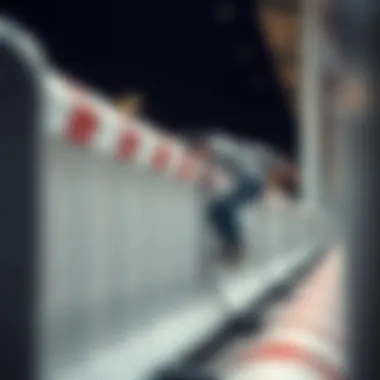
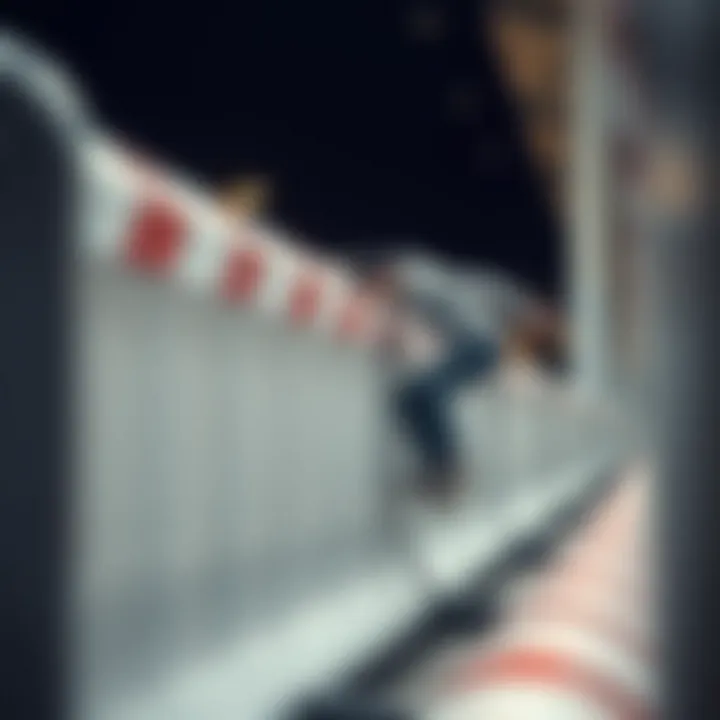
Creative trick development not only influences individual skill levels but also impacts the broader skate culture. It shapes community events where tricks are celebrated, altering the dynamics of how barriers are viewed within a skateboarding context.
In summary, barriers serve as both a challenge and a catalyst for innovation within the skateboarding community. As gear evolves alongside creative trick mastery, both novice and experienced skaters can enjoy a richer, more dynamic experience on their boards. For further exploration of skateboarding innovations, check sources like Wikipedia, and forums on Reddit.
Through understanding the dual role barriers play, stakeholders, including designers and skaters, can advocate for better integration of skate culture into urban settings, making these environments not just functional but also inspirational.
Cultural Perspectives on Barriers
When discussing skateboard barriers, it’s crucial to dive into the cultural perspectives that surround them. These barriers are not merely physical objects; they embody a complex interplay of identity, community engagement, and artistic expression within the skateboarding world. By examining this topic, we unlock layers of meaning that reveal how skaters view their environments and how those environments, in turn, shape the skater identity.
The Skater Identity
The identity of a skater goes beyond just riding a board; it’s about embracing a lifestyle and a culture that often challenges mainstream norms. Skateboarders frequently perceive barriers as symbols of their rebellious spirit. This perspective is deeply rooted in history, as the act of skating itself can be seen as a form of resistance against the constraints imposed by both society and urban landscapes.
- Authenticity and Resilience: A skater’s identity is heavily tied to authenticity and resilience. Barriers—whether they are concrete, social, or artistic—are often viewed as hurdles to overcome. This mindset fosters a unique sense of creativity and innovation. Skaters adapt to their surroundings, using barriers as opportunities to develop new tricks or explore alternative routes. It transforms the skateboarding experience into a raw and personal journey.
- Community Bonds: Barriers also serve as meeting points for skaters. They foster a sense of belonging within the community. When a local spot gets a new rail or ledge, it quickly becomes a hub for skaters seeking to connect. This communal aspect highlights the collaborative nature of skate culture, where shared challenges and victories strengthen bonds among skaters.
"In skating, every barrier can teach you something. We turn limitations into possibilities, creating our own style and story."
Barriers in Skate Art and Media
Art and media play crucial roles in portraying the cultural significance of barriers in skateboarding. They help document the skateboarding experience and amplify its impact.
- Visual Narratives: Skate art, often found on skateboards, in skate parks, or as graffiti in urban areas, frequently incorporates imagery of barriers. Artists depict barriers not just as obstacles but as canvases for their expression. The artistic representation of barriers brings to light themes of struggle and triumph, igniting conversations about what it means to be a skater.
- Film and Video: The media landscape surrounding skateboarding captures the raw essence of riding and the challenges skaters face. Documentaries, skate videos, and even social media platforms like Instagram provide significant space for skaters to showcase their skills while also reflecting on the barriers they encounter. This visibility helps educate outsiders about the culture while reinforcing the identity of skaters themselves.
- Influence of Social Media: Platforms such as Facebook and Reddit act as modern-day skate magazines, showcasing how barriers are an intrinsic part of the skateboarding narrative. Skaters share tricks performed on various obstacles, sparking discussions and inspiring new generations. The collective experience shared online cements the cultural perspectives on barriers, illustrating how interconnected the skate community actually is.
In summary, understanding the cultural perspectives on skateboard barriers enables us to see them as more than just physical structures. They represent a dynamic dialogue that connects skaters through identity, resilience, and artistic expression. The relationships formed through these barriers enrich the skate culture and provide essential insights into the community's values and beliefs.
The Future of Skateboard Barriers
As we move forward, the discussion around skateboard barriers becomes ever more pertinent, touching on not just the mechanics of skateboarding but also the broader implications for urban environments. Skateboard barriers are not only structures; they represent a crossroads where skate culture meets urban planning. This exploration leads us to consider how these barriers can evolve to cater to the skaters’ needs while adhering to safety standards and enhancing the aesthetic of public spaces.
The future of skateboard barriers is intrinsically linked to two key elements: innovation in design and community involvement. Addressing these factors can foster spaces that are welcoming for both skateboarders and non-skaters alike, thus enriching communal interactions.
Design Innovations
The importance of design innovations in the context of skateboard barriers cannot be overstated. The future demands creative solutions that enhance functionality without compromising safety. For example, barriers that incorporate flexible materials or modular designs can adapt to different spaces and user needs.
Consider solutions like integrated skateable elements in urban furniture—like benches that double as skate spots. Such designs not only provide practical riding surfaces but also blend seamlessly into the environment, making them unobtrusive yet functional. Innovation also extends to the use of smart materials that change its properties based on environmental conditions, which could be especially beneficial in areas prone to rain or snow.
Some exciting experiments are already underway. Cities like Barcelona have implemented skate-friendly park designs, combining aesthetic appeal with practical skating surfaces. In parallel, manufacturers are beginning to use lighter, sustainable materials that meet safety prevalence while allowing for unique designs that appeal to skaters.
"Incorporating skateboard-friendly barriers fosters innovation that redefines how urban spaces can function for a diverse group of users."
Moreover, incorporating feedback mechanisms that allow skaters themselves to weigh in on designs can lead to better outcomes. This integration can be achieved through platforms like reddit.com, where skaters share ideas and feedback on local designs. When the end-users participate in the design process, it not just improves usability but also instills a sense of ownership among the skating community.
Community Involvement
Community involvement stands as a pillar in shaping the future of skateboard barriers. Engaging with local skateboarding groups, urban planners, and residents can lead to barriers that respect the needs of both skaters and the general public. Cooperation between these groups can prevent misunderstandings or miscommunications that might arise over shared spaces.
A notable example can be seen in Philadelphia, where local skaters collaborated with city officials to design skate parks that also serve as communal spaces. This collaboration opened the door for dialogue about how recreational needs can coexist within urban landscapes. Community forums and workshops can promote this collaboration further.
The implications of involving the community also extend to maintenance. If skateboarders feel a sense of belonging, they are often more inclined to take care of the spaces designed for them. Consequently, this sense of stewardship can transform how barriers are viewed—from mere obstacles to integral components of an urban ecosystem.
As we look to the horizon, it’s clear that skateboard barriers will play a crucial role in shaping urban lifestyles. The blend of innovative designs with grassroots involvement can yield spaces that honor the essence of skate culture while respecting the footprint it leaves on urban life. By acknowledging these elements, the future can be a canvas where skateboarding flourishes alongside community engagement.
Culmination
The exploration of skateboard barriers reveals their significant duality, acting both as facilitators and constraints within the skateboarding community. Barriers, by their very definition, create boundaries, yet they also shape the environment in which skateboarders express their creativity and skill. This layered perspective is crucial, as understanding the implications of barriers can foster a more enriching skate culture.
The Dual Nature of Barriers
On one hand, barriers provide a framework for trick progression. They direct the flow of skating, guiding skaters toward innovative maneuvers. For instance, a well-placed ledge can transform a mundane skate park into a canvas for artistic expression. In this light, barriers can enhance the skateboarding experience, pushing athletes to develop new techniques and styles as they adapt to various obstacles within their environment.
Conversely, these same barriers can impede accessibility. Many urban settings are wrought with restrictions that diminish the experience for novice and casual skaters. Inadequate spaces or rigid rules regarding skateboarding can push individuals away from the activity, fostering a sense of exclusion. The challenge lies in striking a balance—how can the benefits of barriers as creative tools be maximized while minimizing their isolating effects? Keeping in mind the needs of all skaters—experienced or not—can pave the way for inclusive design in future urban developments.
"Our environment profoundly influences our creativity; skateboarding is no exception. The barriers we face inspire us just as much as they limit us."
Call for Constructive Engagement
Constructive engagement between skaters, urban planners, and local communities is not just beneficial; it’s essential for the evolution of skateboarding within public spaces. By fostering open dialogue, stakeholders can identify and address the needs of the skateboarding community while recognizing the importance of urban aesthetics and safety. This collaborative approach can transform barriers from obstacles into opportunities for community building.
For instance, incorporating feedback from skateboarders in the design of new parks can yield spaces that are not only functional but also inspire creativity. When skaters feel heard, they gain a stake in the development of their environments, which can lead to increased community pride and investment.
Furthermore, community events centered around skateboarding can bridge the gap between skaters and local residents. By creating opportunities for interaction, local governments can demystify skate culture while fostering a collaborative atmosphere that addresses safety concerns without stifling creativity.
In summary, the conclusion emphasizes the dual nature of skateboard barriers and the necessity of facilitating constructive engagement to enhance urban designs. Recognizing the complexities of barriers will empower communities to shape skateboarding environments that are inclusive, safe, and conducive to creativity.






